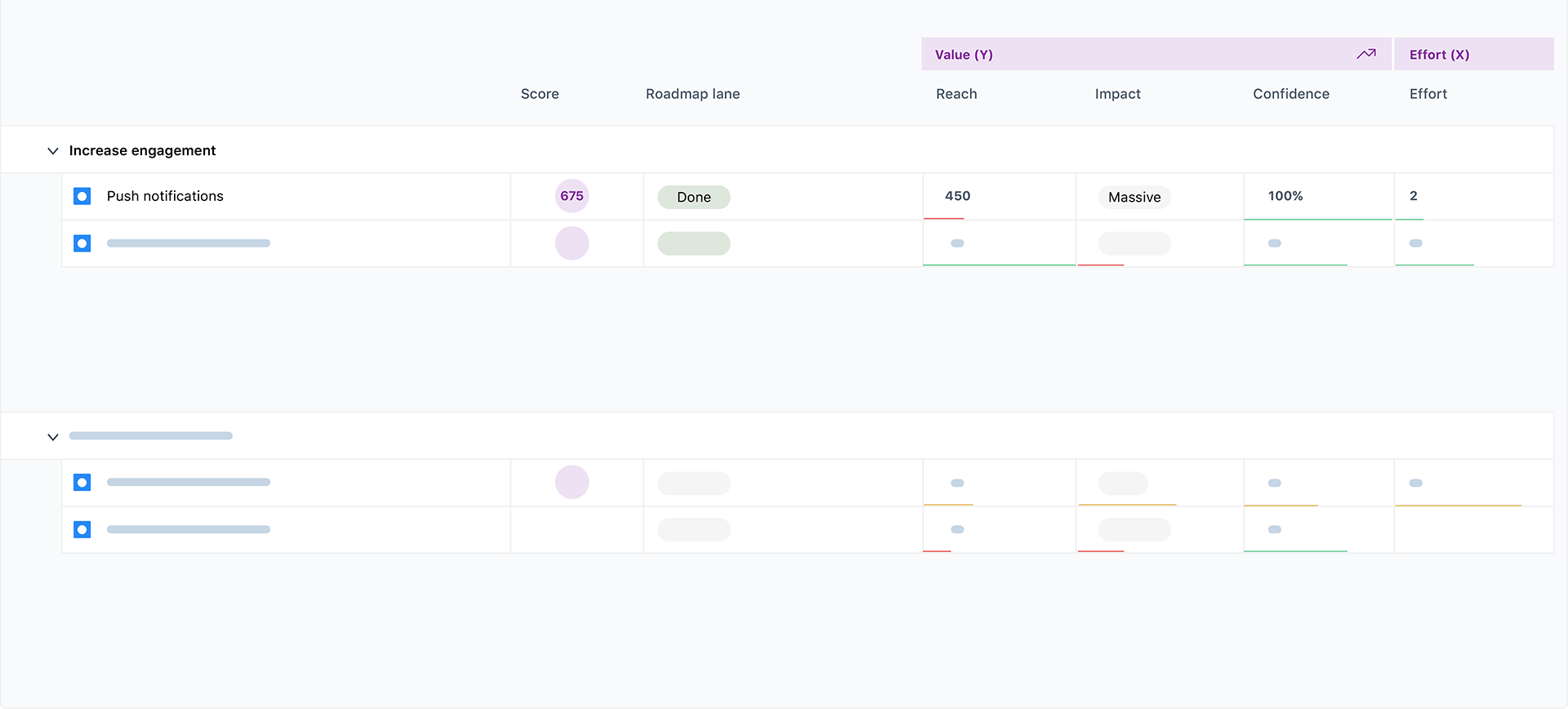
RICE prioritization template
Discover it live
Preview

About the RICE prioritization template
Evaluate and prioritize your product backlog based on Intercom’s popular RICE scoring framework with four criteria: Reach, Impact, Confidence, and Effort. What you get:
A product backlog with a customizable prioritization framework using a custom formula.
A priority chart to visualize your quick wins and timewasters.
More views: Now-next-later roadmap, product timeline.
What is a RICE prioritization template?
The RICE prioritization template is commonly used by product managers and product owners to prioritize feature releases and projects. This framework is structured into four key criteria that form the acronym “RICE”. The RICE prioritization framework helps to avoid bias towards features and projects you personally prefer.
What does RICE stand for?
Each letter in the acronym RICE carries meaning when prioritizing products and features. When putting a RICE-based product roadmap together, you’ll be assessing decisions by:
Reach (R) - the number of users or paying customers that would be affected by this feature.
Impact (I) - the benefit your users are getting from new features. Depending on your use case, it can also mean how much said feature or build will increase your product’s conversion rate.
Confidence (C) - this is the metric that accounts for how sure you are in the estimations you’ve made.
Effort (E) - how much work is required from your team to build a product/feature or finish a project? Depending on the use case, the value type could be person-months or project-hours.
When should you use a RICE prioritization framework template?
The RICE-based product roadmap template is flexible and adaptable. The way this scoring model proves its utility is by forcing you and your team to think through why and how a project will have an impact — and what work is required for that impact to be achieved.
This way, a RICE prioritization template removes the emotion and subjectivity from the thinking process, making it easier for your team to come to a strategic decision.
There’s often more than one compelling idea in the backlog, and assigning priorities can become difficult in a product roadmap. When your team is having a hard time aligning to one course of action, the RICE prioritization template is an easy way to get everyone on the same wavelength.
For ultimate value, the RICE prioritization framework should be used at the very beginning of product development or a new major project, to avoid wasting time.
How to create your own RICE prioritization framework using our template
By using airfocus’s RICE prioritization template, you can create your own RICE framework in a few easy steps.
Start using the template from the airfocus app. The table view is ready for features and projects to be added and the four key RICE criteria are already defined, so there’s no waiting around.
Analyze the Reach of your project. How many people will be affected by this project? Will your client experience benefit? Usually, teams quantify Reach as the amount of people impacted or the number of events taking place during a timeframe. It’s important to use real data to quantify this value, such as product metrics.
What is the Impact of your project? While Reach shows how many people will be affected by your project, Impact quantifies the effect. Of course, it’s difficult to measure the impact of a product before it’s been launched, and that’s why teams use a set scale as a form of evaluation. A common scale is from 1 to 3: 1 is low, 2 is medium, and 3 is high impact.
Set your Confidence level. How much do you believe that your project will have the impact you expect? Even if the idea is great, now might not be the right time, making it a lower priority. Confidence is measured as a percentage: 100% means total confidence, 80% is optimism without certainty, and 50% or under signifies low confidence.
Define the Effort level. What’s the total amount of time it will take to finalize this project? Effort is evaluated by how much time and how many teams will have to contribute to get it over the line.
Calculating the score. In order to get your RICE score, multiply Impact, Confidence and Reach. Then, divide the value by Effort. Or just sit back and let the airfocus RICE template do the math for you.
Now you’re ready to make better, more informed decisions by prioritizing ruthlessly.
This template includes a product backlog with a customizable prioritization framework, a 4x4 priority chart to visualize your quick wins and don’t dos, a ready-to-use now-next-later roadmap, and a timeline to visualize your release plans and delivery work.
Get started with the RICE prioritization template now

Pre-installed apps
Priority Ratings
Set up a custom prioritization framework
Benefits that come from using this template
Powerful prioritization framework
Build a strategic product roadmap
Seamless integrations
Ready to use & fully customizable
Learn how to use airfocus templates effectively
More templates
Experience the new way of doing product management


Experience the new way of doing product management




